LINCOLN MARK VIII 1998 Owners Manual
Manufacturer: LINCOLN, Model Year: 1998, Model line: MARK VIII, Model: LINCOLN MARK VIII 1998Pages: 170, PDF Size: 1.37 MB
Page 141 of 170

²Be particularly careful if you are taking ªAntabuseº or other forms of
disulfiram for the treatment of alcoholism. Breathing gasoline vapors
or skin contact could cause an adverse reaction. Consult a physician
immediately.
Choosing the right fuel
Use only UNLEADED FUEL. The use of leaded fuel is prohibited by law
and could damage your vehicle.
Your vehicle was not designed to use fuel or fuel additives with metallic
compounds, including manganese-based compounds containing MMT.
Vehicles certified to California emission standards (indicated on the
underhood Vehicle Emissions Control Information label) are designed to
operate on California reformulated gasolines. If California reformulated
gasoline is not available when you refuel, your vehicle can be operated
on non-California fuels. However, even though your engine will perform
adequately on other gasolines, the performance of the emission control
devices and systems may be adversely affected.
Repair of damage caused by using a fuel that your vehicle was not
designed for may not be covered by your warranty.
Octane recommendations
Your vehicle is designed to use
ªPremiumº gasoline for optimum
performance with an (R+M)/
2 octane rating of 91 or higher.
Gasolines with lower octance ratings
can be used, but performance may
decrease. We do not recommend
gasolines labeled as ªPremiumº in
high altitude areas that are sold with octane ratings less than 91.
Do not be concerned if your vehicle sometimes knocks lightly. However,
if it knocks heavily under most driving conditions on fuel with the
recommended octane, see your dealer or a qualified service technician to
prevent any engine damage.
Fuel quality
If you are experiencing starting, rough idle or hesitation driveability
problems during a cold start, try a different brand of ªRegularº gasoline.
ªPremiumº gasoline is not recommended (particularly in the United
91(R+M)/2 METHOD
Maintenance and care
142
Page 142 of 170

States) because it may cause these problems to become more
pronounced. If the problems persist, see your dealer or a qualified
service technician.
The American Automobile Manufacturers Association (AAMA) issued a
gasoline specification to provide information on high quality fuels that
optimize the performance of your vehicle. We recommend the use of
gasolines that meet the AAMA specification if they are available.
It should not be necessary to add any aftermarket products to your fuel
tank if you continue to use a high-quality fuel.
Cleaner air
Ford approves the use of gasolines to improve air quality, including
reformulated gasolines that contain oxygenates up to 10% ethanol or
15% MTBE.
Do not use gasolines containing methanol, which can damage critical fuel
system components. Damage resulting from the use of methanol may not
be covered by your warranty.
Running out of fuel
Avoid running out fuel because this situation may have an adverse affect
on modern powertrain components.
You may need to crank the engine several times before the system starts
to pump fuel from the tank to the engine. If you run out of fuel, your
Check Engine light may come on. For more information on the Check
Engine light, refer to theInstrumentationchapter.
Calculating fuel economy
To accurately calculate your vehicle's fuel economy:
1. Fill the tank completely and record the initial odometer reading.
2. Each time you fill the tank, record the amount of fuel added (in liters
or gallons).
3. After at least three to five fuel tank fill-ups, fill the fuel tank and
record the current mileage reading.
4. Use one of the following equations to calculate fuel economy.
Liters used x 1004Total kilometers traveled
Total miles traveled4Total gallons used
Maintenance and care
143
Page 143 of 170
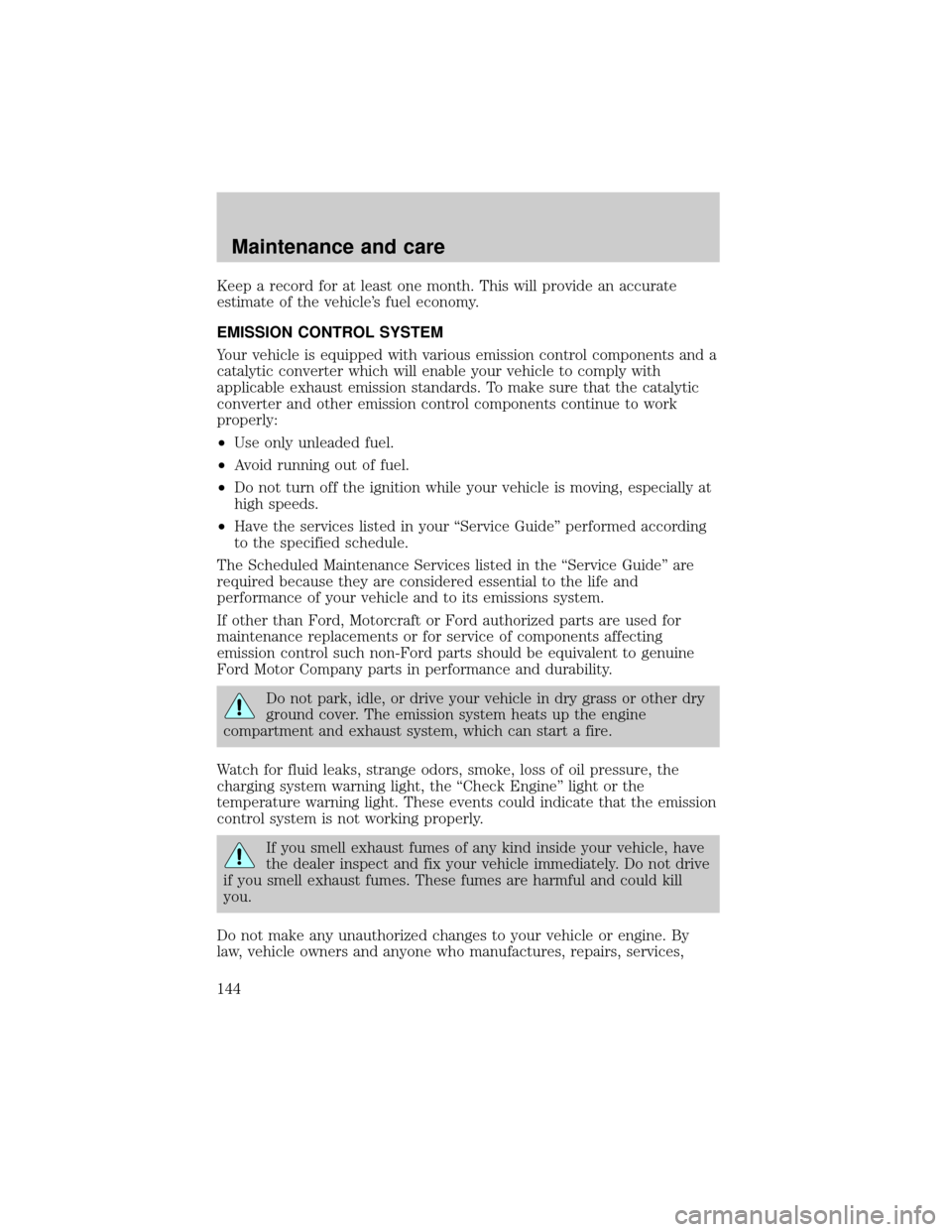
Keep a record for at least one month. This will provide an accurate
estimate of the vehicle's fuel economy.
EMISSION CONTROL SYSTEM
Your vehicle is equipped with various emission control components and a
catalytic converter which will enable your vehicle to comply with
applicable exhaust emission standards. To make sure that the catalytic
converter and other emission control components continue to work
properly:
²Use only unleaded fuel.
²Avoid running out of fuel.
²Do not turn off the ignition while your vehicle is moving, especially at
high speeds.
²Have the services listed in your ªService Guideº performed according
to the specified schedule.
The Scheduled Maintenance Services listed in the ªService Guideº are
required because they are considered essential to the life and
performance of your vehicle and to its emissions system.
If other than Ford, Motorcraft or Ford authorized parts are used for
maintenance replacements or for service of components affecting
emission control such non-Ford parts should be equivalent to genuine
Ford Motor Company parts in performance and durability.
Do not park, idle, or drive your vehicle in dry grass or other dry
ground cover. The emission system heats up the engine
compartment and exhaust system, which can start a fire.
Watch for fluid leaks, strange odors, smoke, loss of oil pressure, the
charging system warning light, the ªCheck Engineº light or the
temperature warning light. These events could indicate that the emission
control system is not working properly.
If you smell exhaust fumes of any kind inside your vehicle, have
the dealer inspect and fix your vehicle immediately. Do not drive
if you smell exhaust fumes. These fumes are harmful and could kill
you.
Do not make any unauthorized changes to your vehicle or engine. By
law, vehicle owners and anyone who manufactures, repairs, services,
Maintenance and care
144
Page 144 of 170

sells, leases, trades vehicles, or supervises a fleet of vehicles are not
permitted to intentionally remove an emission control device or prevent
it from working. Information about your vehicle's emission system is on
the Vehicle Emission Control Information Decal located on or near the
engine. This decal identifies engine displacement and gives some tune up
specifications.
Please consult your ªWarranty Guideº for complete emission warranty
information.
Readiness for inspection/maintenance (I/M) testing
In some localities, it may be a legal requirement to pass an I/M test of
the on-board diagnostic (OBD-II) system. If your ªcheck engine/service
engine soonº light is on, reference the applicable light description in the
Warning Lights and Chimessection of your owners guide. Your vehicle
may not pass the I/M test with the ªcheck engine/service engine soonº
light on.
If the vehicle's powertrain system or its battery has just been serviced,
the OBD-II system is reset to a ªnot ready for I/M testº condition. To
ready the OBD-II system for I/M testing, a minimum of 30 minutes of city
and highway driving is necessary as described below:
²First, at least 10 minutes of driving on an expressway or highway.
²Next, at least 20 minutes driving in stop and go, city type traffic with
at least four idle periods.
Allow the vehicle to sit for at least eight hours without starting the
engine. Then, start the engine and complete the above driving cycle. The
engine must warm up to its normal operating temperature. Once started,
do not turn off the engine until the above driving cycle is complete.
EXTERIOR BULBS
Replacing exterior bulbs
Check the operation of the following lamps frequently:
²Headlamps
²Tail lamps
²Brakelamps
²High-mount brakelamp
²Turn signals
Maintenance and care
145
Page 145 of 170

²Backup lamps
²License plate lamp
Do not remove lamp bulbs unless they will be replaced immediately. If a
bulb is removed for an extended period of time, contaminants may enter
the lamp housings and affect performance.
Replacing headlamp bulbs
The high beam headlamps on your vehicle use halogen bulbs. If the lamp
burns out, simply replace it with a new one.
Handle a halogen headlamp bulb carefully and keep out of
children's reach. Grasp the bulb only by its plastic base and do
not touch the glass. The oil from your hand could cause the bulb to
break the next time the headlamps are operated.
Unlike the high beam headlamps, the low beam headlamps on your
vehicle use a ªhigh intensity dischargeº source. These lamps operate at a
high voltage.
Low beam headlamps that flicker, are dim, or appear yellow or red
should be replaced using the following instructions provided the vehicle
is equipped with an orange sticker displayed near the front of the engine
compartment which reads WARNING: HIGH VOLTAGE.
Take your vehicle to your Lincoln Mercury dealer for service if:
²One or both of your low beam headlamp bulbs are burned out and the
orange sticker which reads WARNING: HIGH VOLTAGE is not
displayed near the front of the engine compartment or
²The message center displays ªCHECK HEADLAMPS.º
Replacing the low beam headlamp bulb
1. Make sure the headlamp switch is
in the OFF position.
2. Lift the hood and disconnect the
battery ground cable.
3. Remove the sight shield located
above the headlamps.
Maintenance and care
146
Page 146 of 170
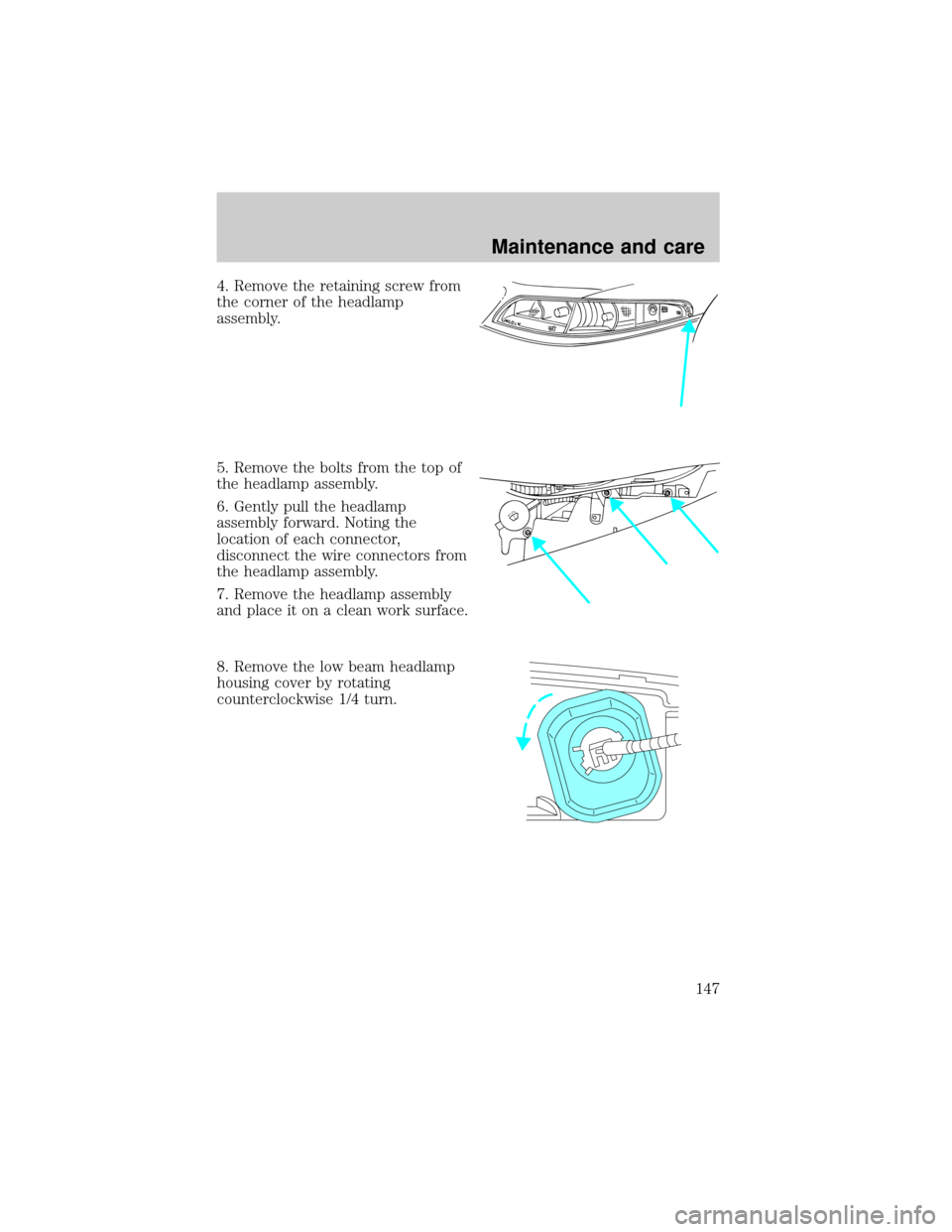
4. Remove the retaining screw from
the corner of the headlamp
assembly.
5. Remove the bolts from the top of
the headlamp assembly.
6. Gently pull the headlamp
assembly forward. Noting the
location of each connector,
disconnect the wire connectors from
the headlamp assembly.
7. Remove the headlamp assembly
and place it on a clean work surface.
8. Remove the low beam headlamp
housing cover by rotating
counterclockwise 1/4 turn.
Maintenance and care
147
Page 147 of 170

9. Remove the headlamp bulb
retaining nuts.
10. Remove the headlamp bulb
assembly.
11. Slide the headlamp level and
bracket off the bulb assembly and
remove.
12. Twist headlamp housing
counterclockwise to remove
headlamp bulb from socket.
Maintenance and care
148
Page 148 of 170
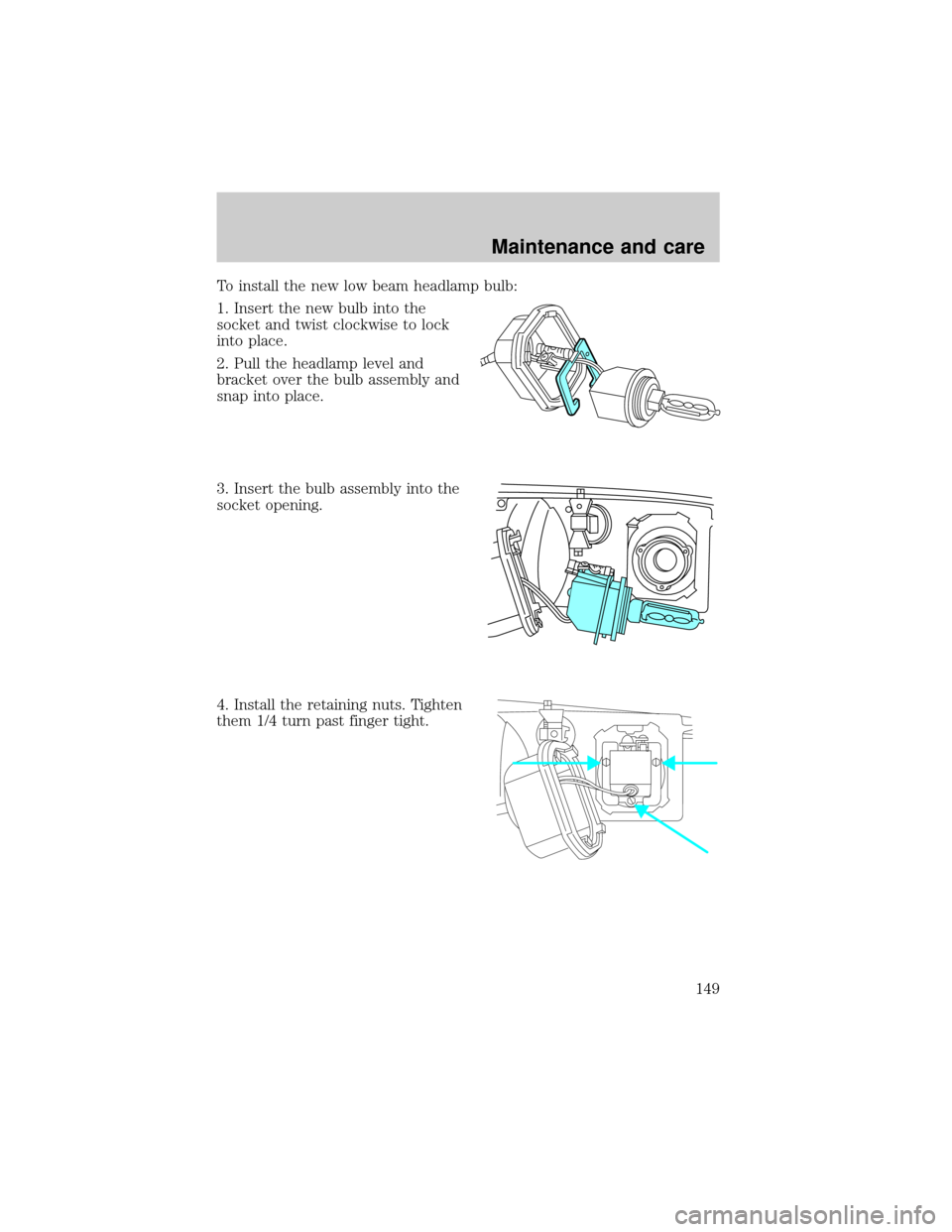
To install the new low beam headlamp bulb:
1. Insert the new bulb into the
socket and twist clockwise to lock
into place.
2. Pull the headlamp level and
bracket over the bulb assembly and
snap into place.
3. Insert the bulb assembly into the
socket opening.
4. Install the retaining nuts. Tighten
them 1/4 turn past finger tight.
Maintenance and care
149
Page 149 of 170
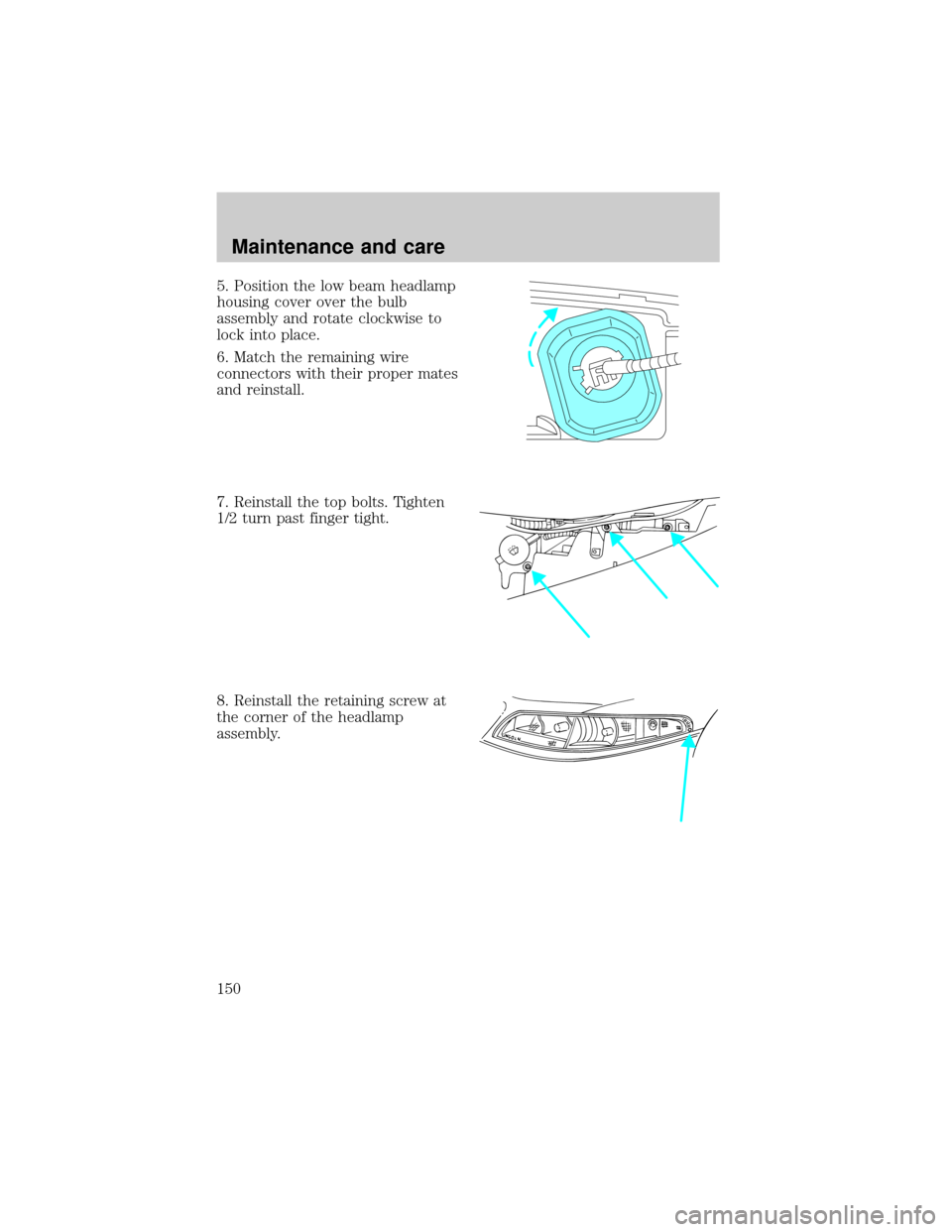
5. Position the low beam headlamp
housing cover over the bulb
assembly and rotate clockwise to
lock into place.
6. Match the remaining wire
connectors with their proper mates
and reinstall.
7. Reinstall the top bolts. Tighten
1/2 turn past finger tight.
8. Reinstall the retaining screw at
the corner of the headlamp
assembly.
Maintenance and care
150
Page 150 of 170
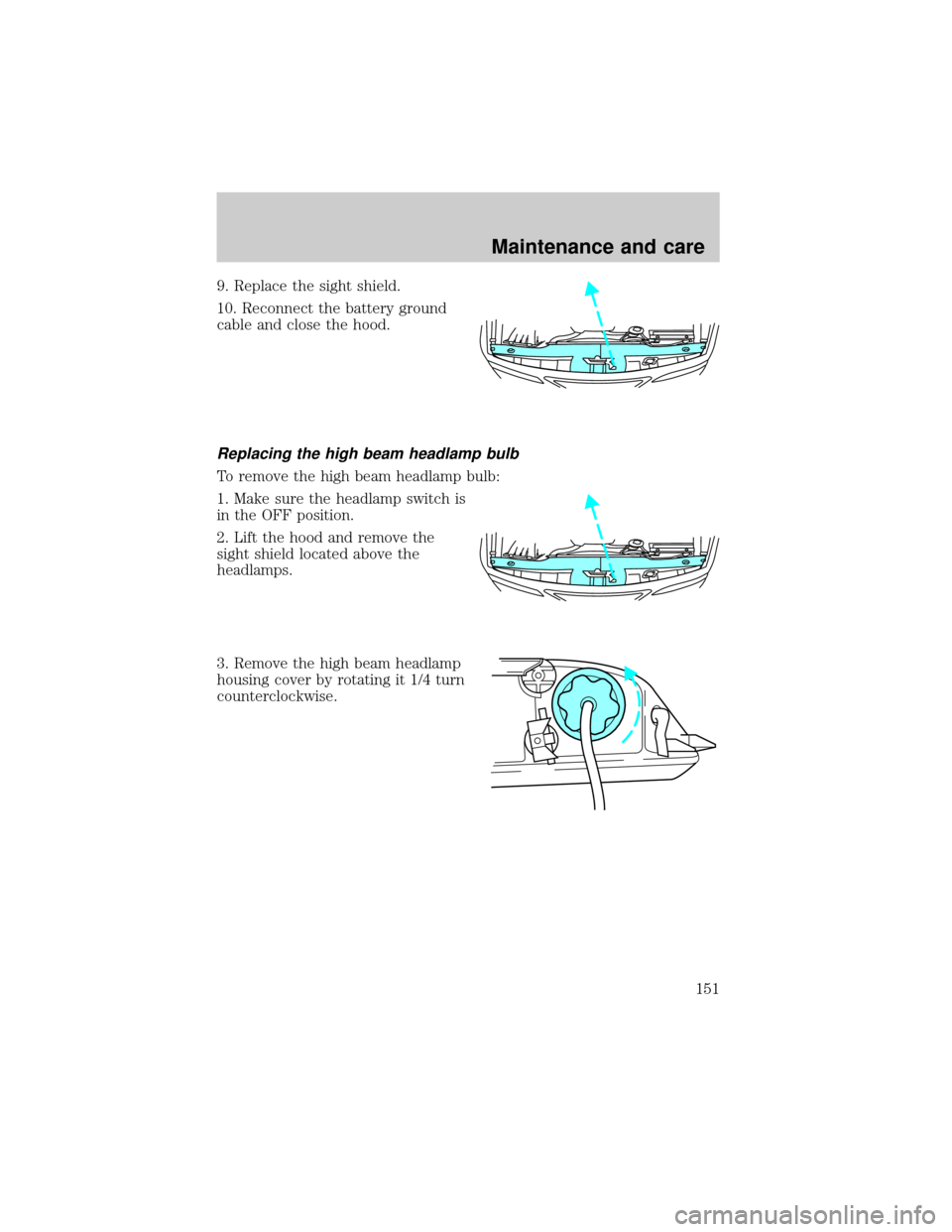
9. Replace the sight shield.
10. Reconnect the battery ground
cable and close the hood.
Replacing the high beam headlamp bulb
To remove the high beam headlamp bulb:
1. Make sure the headlamp switch is
in the OFF position.
2. Lift the hood and remove the
sight shield located above the
headlamps.
3. Remove the high beam headlamp
housing cover by rotating it 1/4 turn
counterclockwise.
Maintenance and care
151